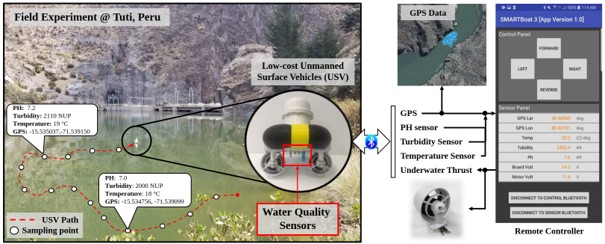UNSA Projects
It is to develop environmental robotics applications.
Environmental Unmannded Surfce Vessles (USV): SMARTmBOAT series
(a) Water monitoring USV: SMARTmBOAT-03

We propose a new, fully open-source, low-cost, and small-sized Unmanned Surface Vehicle (USV) for measuring near-surface water quality in real time in various environments. Existing commercial USVs are expensive and not fully based on open-source hardware, making it difficult to purchase them and to modify their designs and programming to suit various environments. In contrast, the USV platform proposed in this paper is completely open-source, from hardware to software; most parts of the platform can be 3D-printed, and it can be easily modified and upgraded in terms of both design and programming. The platform is equipped with off-the-shelf water sensors for acquiring data like as pH, turbidity, and temperature to measure water quality in real water resources (such as ponds, reservoirs, and lakes). Furthermore, we provide an Android application through which users can easily control the USV via Bluetooth and display the sensor and GPS data the platform generates. We validated the performance of the platform in terms of usability, mobility, and stability through field experiments in various locations, including both the USA and Peru. Moreover, we present a potential application and approach in which this platform can navigate autonomously by utilizing the Robot Operating System (ROS) and Bluetooth protocols.
- Repository: https://osf.io/wsnrt/
- Video: https://youtu.be/OBqA9pRZ8pM
- Paper: Wonse Jo, Hoashi, Y., Aguilar, L. L. P., Postigo-Malaga, M., Garcia-Bravo, J. M., & Min, B. C. (2019). A low-cost and small USV platform for water quality monitoring. HardwareX, 6, e00076; Link
(b) Water monitoring USV: SMARTmBOAT-04

We propose a new and small USV platform to overcome the limitations of existing robot systems. The main feature of the proposed USV is that it is designed as a vertically symmetrical structure, so that it can continuously perform its mission even when the USV is capsized. Moreover, the USV system can automatically check whether the robot has been capsized via GPS and IMU sensors installed on the USV, and carry out the mission regardless of whether it is overturned, by controlling three waterproof servo motors according to the USV’s orientation, to rotate two main thrusters and the water sensor module. The USV measures water quality and depth in real-time through a Total Dissolved Solids (TDS) sensor, a temperature sensor, and a Ping sensor that measures water depth. A forward-facing camera allows the USV to autonomously avoid obstacles using computer vision. All data is transmitted in real-time to the user interface or main system using Robot Operating System 2 (ROS2), the latest robot middleware that supports real-time control.
- Poster: Wonse Jo, Pou hei Chan, Chad T. Jafvert, Mauricio Postigo-Malaga, and Byung-Cheol Min, "Development of a Vertically Symmetrical Unmanned Surface Vessel (VSUSV) for Bathymetric and Water Quality Surveys of Surface Waters," 2020 the 7th Annual C4E Environmental Community Mixer, Purdue University, Oct. 2020.
(c) Algae Removal USV: SMARTmBOAT-05

We introduce a small and low-cost unmanned surface vehicle (USV), the SMARTBoat 5, capable of removing harmful algal blooms (HABs), which are a rising environmental issue worldwide. The developed USV is a hovercraft type, operated by two propellers with duct fans; it is able to freely move even in shallow water and to approach shorelines. For eco-friendly, immediate, and safe control of algae, the USV is equipped with a novel water suction mechanism that enables it to actively collect algae without physical contact. In addition, it is equipped with a mesh net-based algae filter system that is easily disassembled and replaced. The USV system is supported by the Robot Operating System (ROS) for expandability and use in diverse applications. The performance of the proposed water suction mechanism and USV platform overall are validated through computational fluid simulation (CFD) and experiments in both lab and real environments.
- Repository: https://github.com/SMARTlab-Purdue/Harmful-Algae-Removal-USV
- Video: https://youtu.be/8BPvFbJgXho
- Paper: Wonse Jo, J. Park, Y. Hoashi and B. Min, "Development of an Unmanned Surface Vehicle for Harmful Algae Removal," OCEANS 2019 MTS/IEEE SEATTLE, 2019, pp. 1-7, doi: 10.23919/OCEANS40490.2019.8962677; Link